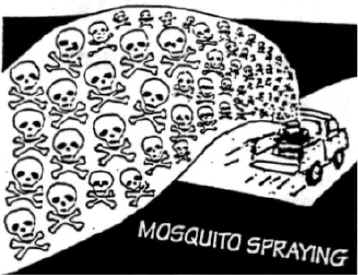 |
No Spray News James Irwin |
 |
No Spray News James Irwin |
May 21, 2002 Page 5
A Startling Finding in Louisiana
Seventeen parishes provided Cx. quinquefasciatus to be assayed for resistance against the adulticides.
Note: this mosquito is considered a key species in the transmission of WNV in the southern U.S., and is the main species that the city (and probably the county as well) claim to spray for.
Results from this test indicate that seven populations are resistant to permethrin in the following parishes: Ouachita, Lincoln, Jeff Davis, Ascension, Livingston, St. Tammany, and St. Bernard. Mosquito populations in both Lincoln and Livingston parishes show resistance to permethrin, yet neither are subjected to organized mosquito control.
All populations tested against malathion were resistant, including populations from five of the seven parishes where no control methods are used. What is even more surprising is the level of resistance seen against this insecticide. Resistance ratios are used to determine levels of resistance and are calculated by dividing the LD50 of the field collected population by the LD50 of the susceptible population. Any population having a ratio above five was considered resistant. Ratios for malathion ranged from the mid-2Os to 208, with most populations failing around 50.
Resistance is being seen in many of Louisiana's mosquito populations and it is occurring in more than just one class of insecticides. The way insecticides were previously used plays an important role in the extent of resistance that we are seeing today. In the past, routine spraying was a common practice. The only way that resistance can be slowed is if we start using our remaining insecticides wisely.
Source: Winter 1999 Society of Vector Ecology Newsletter
Note: This is just one of 4 studies I am aware of that document Culex quinquefasciatus' proclivity for developing resistance/tolerance to insecticides used in mosquito spraying.
Are Mosquitoes Here Resistant?
No One Knows
That's right - the insecticide malathion has been sprayed in Richland County since 1968 for a mosquito that is notorious for developing resistance to it, without anyone ever checking to see if the mosquito has developed resistance.
Yet Richland County Vector Control's Tammie Brewer, in her April 16 letter to County Council defending spraying, claimed that: "There is no evidence to suggest that the mosquitoes in Richland Countlv are resistant to malathion."
Isn't that a case of not finding what you're not looking for?